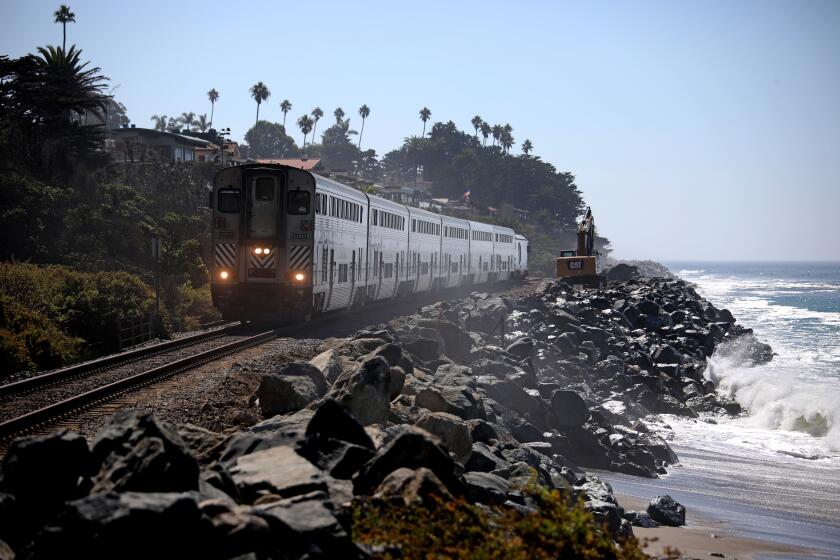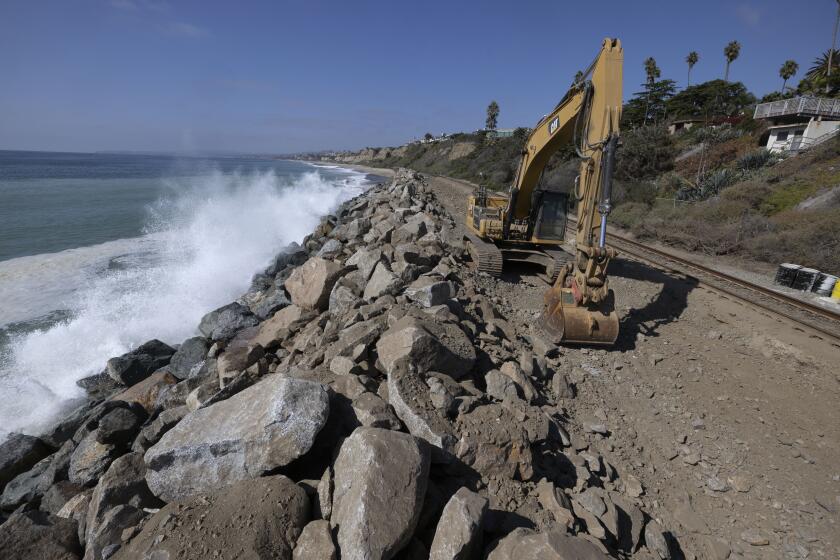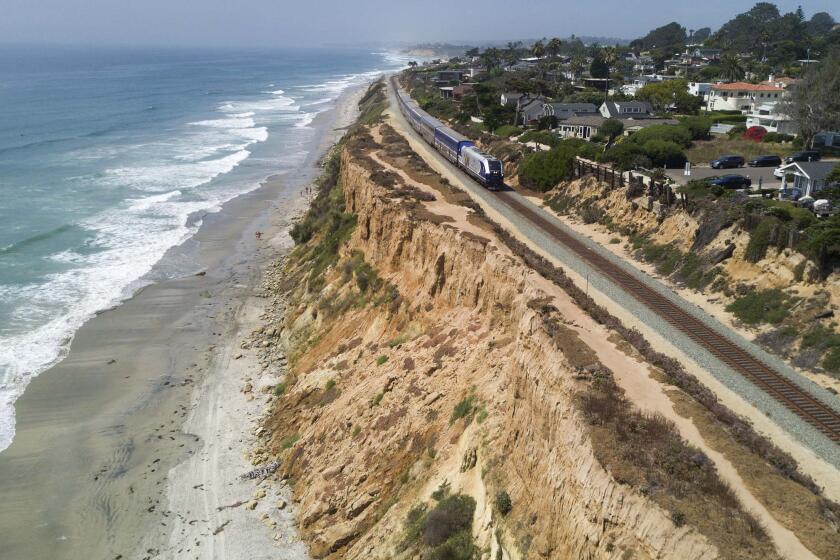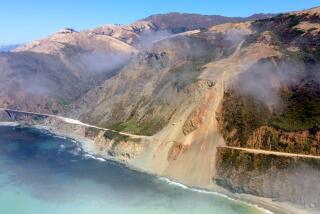Erosion repairs could halt passenger rail service to San Diego through year’s end
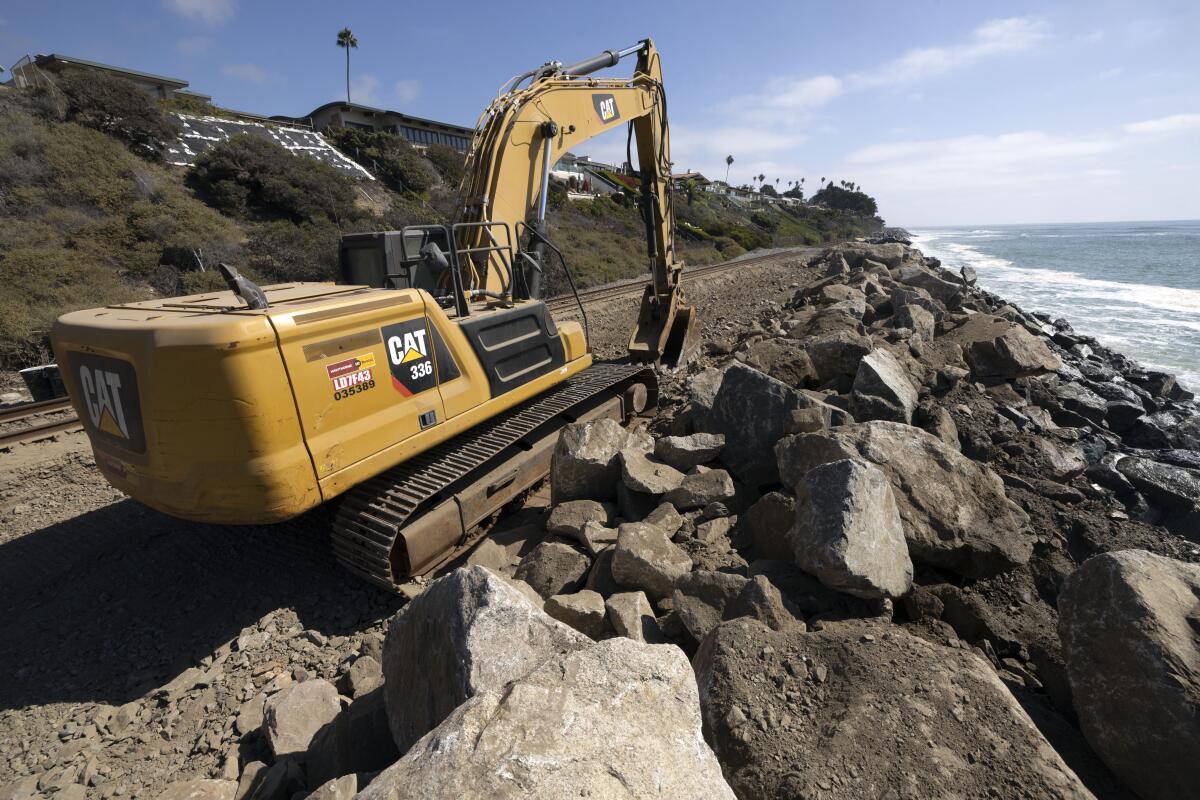
- Share via
Work to protect the railroad tracks on an unstable slope in San Clemente is now expected to stop all passenger train service between San Diego and Orange counties through at least mid-December.
Metrolink and Amtrak both suspended service Sept. 30 after movement was again detected in the area of an old landslide just north of the San Diego County border that for years has caused periodic difficulties for the railroad.
Initially, transit officials said service would be restored in November, but Friday they announced that a contract for emergency repairs had been awarded and that the work could keep passenger trains off the tracks through the end of the year.
“The new timeline of mid-January for the completion of construction — and a mid-December decision on the restoration of passenger rail service — came about in discussions with the signed contractor, Condon-Johnson, which was not the original construction firm contracted,” Orange County Transportation Authority spokesman Eric Carpenter said by email Tuesday.
The construction timeline is subject to change depending on factors including right-of-way negotiations, permitting, inclement weather and securing necessary construction materials, Carpenter said.
“The contractor is working on the final design,” he said. “The right-of-way and permitting processes also are being finalized. The actual construction work is expected to start later this month, and OCTA will reach out to nearby property owners to notify them of the work schedule.”
Officials with Metrolink are still responding to recent movement detected in the railway’s foundation near San Clemente after Tropical Storm Kay.
The 140-year-old coastal rail line is the only viable route for passenger and freight trains between San Diego and the rest of the United States. The 350-mile line between San Diego, Los Angeles and San Luis Obispo, known as the LOSSAN corridor, is one of the nation’s busiest rail routes.
Repairs are expected to cost as much as $12 million. The agency awarded a contract Friday to Condon-Johnson & Associates, a geotechnical contractor with offices in Los Angeles and San Diego. Engineers and geotechnical experts will monitor the slope next to the tracks throughout construction.
BNSF, which operates freight trains serving San Diego, is delivering construction materials to the work site by rail. It also operates a single freight train daily at reduced speed through the area. Normally, BNSF has six or more freight trains daily serving San Diego, usually running at night to avoid passenger trains.
North County Transit District continues to operate Coaster commuter trains on their regular schedule between Oceanside and San Diego and has added runs for the Padres baseball playoff games.
Amtrak has trains running between the Santa Fe Depot in downtown San Diego and Oceanside, and is providing bus service between Oceanside and the Amtrak station in Irvine. Metrolink trains, which normally stop in Oceanside, are unavailable south of the Laguna Niguel/Mission Viejo Metrolink station during the suspension.
“We’re in uncharted territory with this emergency stabilization work and, as we’ve said all along, passenger safety is what guides all our actions,” Mark Murphy, the OCTA board chairman and mayor of Orange, said in a news release. “We want this work to get done as soon as possible, but we first need to make sure it’s done right and the slope is secure.”
California and Orange County transportation officials declared an emergency and approved $6 million this week for construction to stabilize the sliding railroad tracks in San Clemente.
The tracks have moved about 28 inches over the last 13 months, most of that last year, in a 700-foot section near the Cyprus Shore community in southern San Clemente, transit officials said.
More than 18,000 tons of rock were placed along the beach after storms caused beach erosion in September 2021. Passenger rail service was suspended for about three weeks during that work.
Rain combined with ocean waves and storm surge in September this year again eroded the coastal side of the tracks and aggravated the gradually sliding slope on the other side. In recent weeks, contractors have added more boulders to the existing riprap along the beach to protect the railroad.
Construction under the new contract will involve placing angled concrete-and-steel retention plates along the slope attached to steel anchors drilled 100 feet horizontally into the bedrock.
Annual ridership is nearly 3 million on Amtrak’s Pacific Surfliner trains and 5 million on Coaster and Metrolink trains. Freight trains carry $1 billion in goods annually on the LOSSAN corridor, according to a 2021 report by state Secretary of Transportation David S. Kim.
In San Diego County, BNSF primarily serves the rail terminals at the Port of San Diego, carrying goods including new foreign cars, building supplies and wind turbine blades. One shipping company, the Pasha Group, has its own 157-acre terminal at the port, where it processes up to 400,000 vehicles annually, nearly all of which arrive on ships and are taken out of San Diego by rail.
A spokesperson for the Pasha Group recently referred questions about shipping to BNSF, and a BNSF representative has not returned calls.
The San Clemente section of tracks is one of at least two vulnerable links in the Southern California stretch of the railroad corridor. The other is the bluff-top tracks in Del Mar near San Diego.
Transportation officials said project to relocate critical rail line could break ground within three years and be completed by 2030.
Regional officials have been working for years on preliminary plans to reroute the 1.7 miles of tracks in Del Mar away from the coast and into a tunnel beneath the small city. This year the state awarded $300 million to the San Diego Assn. of Governments to further that plan, although construction is unfunded, probably would take a decade or longer and is still years from beginning. Costs have been estimated at $4 billion or more.
SANDAG and NCTD, like Orange County transit officials, are focusing on safeguarding the tracks where they are.
“Stabilization efforts in Del Mar are engineered to secure the Del Mar bluffs until at least 2056,” NCTD Executive Director Matt Tucker said in an emailed response to recent questions.
“Upon completion, the current stabilization project ... is projected to stabilize the bluffs for 30 years, which could be extended with future enhancements,” Tucker said.
The fifth phase of Del Mar bluff stabilization work is expected to begin next year and is fully funded for more than $65 million. Plans call for the installation of more than 2,500 feet of new seawalls, more concrete-and-steel soldier piles, drainage ditches, a trail along the upper bluff and pedestrian crossings.
The San Clemente section of tracks eventually also may need to be moved away from the coast, but so far no significant studies have been done.
San Clemente’s fundamental difficulty is the landslide, unlike Del Mar, where the primary problem is the advancing coastal erosion.
“OCTA continues to review long-term options for protecting the rail line in this area and throughout the coastal regional,” transit officials said in Friday’s news release. “OCTA’s priority is to work with all partners to move forward with slope stabilization to ensure safety for all passengers who travel through the area.”
The California Transportation Commission met in special session Oct. 3 to authorize $6 million in emergency funding for the San Clement repairs, which is only half of the estimated cost. OCTA is working with state and federal officials to secure the remainder of the money needed.
More to Read
Sign up for Essential California
The most important California stories and recommendations in your inbox every morning.
You may occasionally receive promotional content from the Los Angeles Times.
